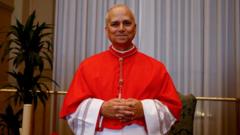The conclave entered its second day, with no consensus reached among the cardinals following inconclusive votes, indicated by the black smoke emanating from the Sistine Chapel. As the need for unity among the diverse group weighs heavily, observers await the potential for a breakthrough in the coming sessions.
Delay in Papal Conclave Continues as Black Smoke Signals No Decision

Delay in Papal Conclave Continues as Black Smoke Signals No Decision
The Vatican's ongoing conclave faces uncertainty as cardinals fail to elect a new pope, signaling the need for further deliberations.
Black smoke emerged from the chimney of the Sistine Chapel on Thursday, indicating that the 133 cardinals assembled to elect a new pope had not reached a decision on the second day of voting. This outcome followed the first ballot on Wednesday evening, which lasted over three hours but resulted in no clear majority. The anticipation among the onlookers in St. Peter's Square was palpable, but the morning's black smoke led to murmurs of disappointment.
The conclave is convened after the death of Pope Francis and is notable as it marks the first voting session in over a decade. This process is steeped in history and tradition, involving rounds of secret votes until a candidate achieves the required two-thirds majority of votes. Should a consensus be reached, white smoke will signal to the public that a new pontiff has been chosen.
The cardinals, primarily privy to each other's backgrounds and political styles, find themselves under pressure as they break for lunch before reconvening for two more voting rounds. Experts note the unprecedented diversity in this conclave, with many cardinals appointed by Francis meeting for the first time—a factor that might contribute to a prolonged voting process, as differing priorities and associated ideologies are brought into play.
Historically, conclaves have varied significantly in duration—with the most protracted stretching to nearly three years in the 13th century, while more recent conclaves took only two days to elect a pope. This reveals a trend toward expedited selections compared to centuries past.
As both anticipation and tension mount among the public and cardinals, it remains unclear how long this conclave may linger. The call for "unity" among cardinals has revealed ideological divides, further complicating the voting process. Observers both inside and outside the Vatican are keenly aware that this election not only determines the next pope but also reflects the broader direction of the Catholic Church in an evolving global context.
The conclave is convened after the death of Pope Francis and is notable as it marks the first voting session in over a decade. This process is steeped in history and tradition, involving rounds of secret votes until a candidate achieves the required two-thirds majority of votes. Should a consensus be reached, white smoke will signal to the public that a new pontiff has been chosen.
The cardinals, primarily privy to each other's backgrounds and political styles, find themselves under pressure as they break for lunch before reconvening for two more voting rounds. Experts note the unprecedented diversity in this conclave, with many cardinals appointed by Francis meeting for the first time—a factor that might contribute to a prolonged voting process, as differing priorities and associated ideologies are brought into play.
Historically, conclaves have varied significantly in duration—with the most protracted stretching to nearly three years in the 13th century, while more recent conclaves took only two days to elect a pope. This reveals a trend toward expedited selections compared to centuries past.
As both anticipation and tension mount among the public and cardinals, it remains unclear how long this conclave may linger. The call for "unity" among cardinals has revealed ideological divides, further complicating the voting process. Observers both inside and outside the Vatican are keenly aware that this election not only determines the next pope but also reflects the broader direction of the Catholic Church in an evolving global context.






















